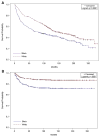The influence of comorbid conditions on racial disparities in endometrial cancer survival
- PMID: 24954655
- PMCID: PMC4253020
- DOI: 10.1016/j.ajog.2014.06.036
The influence of comorbid conditions on racial disparities in endometrial cancer survival
Abstract
Objective: There are known disparities in endometrial cancer survival with black women who experience a greater risk of death compared with white women. The purpose of this investigation was to evaluate the role of comorbid conditions as modifiers of endometrial cancer survival by race.
Study design: Two hundred seventy-one black women and 356 white women who had been diagnosed with endometrial cancer from 1990-2005 were identified from a large urban integrated health center. A retrospective chart review was conducted to gather information on comorbid conditions and other known demographic and clinical predictors of survival.
Results: Black women experienced a higher hazard of death from any cause (hazard ratio [HR] 1.51; 95% confidence interval [CI], 1.22-1.87) and from endometrial cancer (HR, 2.42; 95% CI, 1.63-3.60). After adjustment for known clinical prognostic factors and comorbid conditions, the hazard of death for black women was elevated but no longer statistically significant for overall survival (HR, 1.22; 95% CI, 0.94-1.57), and the hazard of death from endometrial cancer remained significantly increased (HR, 2.27; 95% CI, 1.39-3.68). Both black and white women with a history of hypertension experienced a lower hazard of death from endometrial cancer (HR, 0.47; 95% CI, 0.23-0.98; and HR, 0.35; 95% CI, 0.19-0.67, respectively).
Conclusion: The higher prevalence of comorbid conditions among black women does not explain fully the racial disparities that are seen in endometrial cancer survival. The association between hypertension and a lower hazard of death from endometrial cancer is intriguing, and further investigation into the underlying mechanism is needed.
Keywords: comorbid condition; disease-specific survival; endometrial cancer; hypertension; racial disparity.
Copyright © 2014. Published by Elsevier Inc.
Conflict of interest statement
The authors report no conflict of interest.
Figures
Similar articles
-
Endometrial cancer in morbidly obese women: do racial disparities affect surgical or survival outcomes?Gynecol Oncol. 2014 Apr;133(1):38-42. doi: 10.1016/j.ygyno.2014.01.013. Gynecol Oncol. 2014. PMID: 24680590 Free PMC article.
-
Racial disparities in young women with endometrial cancer.Gynecol Oncol. 2018 Mar;148(3):527-534. doi: 10.1016/j.ygyno.2017.12.032. Epub 2018 Jan 5. Gynecol Oncol. 2018. PMID: 29307452 Free PMC article.
-
The impact of race and comorbidity on survival in endometrial cancer.Cancer Epidemiol Biomarkers Prev. 2012 May;21(5):753-60. doi: 10.1158/1055-9965.EPI-11-0735. Epub 2012 Mar 16. Cancer Epidemiol Biomarkers Prev. 2012. PMID: 22426148
-
Racial disparities in endometrial cancer: Where are we after 26 years?Gynecol Oncol. 2024 May;184:236-242. doi: 10.1016/j.ygyno.2024.01.054. Epub 2024 Feb 20. Gynecol Oncol. 2024. PMID: 38382150
-
Disparities in uterine cancer epidemiology, treatment, and survival among African Americans in the United States.Gynecol Oncol. 2013 Sep;130(3):652-9. doi: 10.1016/j.ygyno.2013.05.020. Epub 2013 May 23. Gynecol Oncol. 2013. PMID: 23707671 Free PMC article. Review.
Cited by
-
A Review of Research on Disparities in the Care of Black and White Patients With Cancer in Detroit.Front Oncol. 2021 Jul 7;11:690390. doi: 10.3389/fonc.2021.690390. eCollection 2021. Front Oncol. 2021. PMID: 34336677 Free PMC article. Review.
-
History of hypertension, heart disease, and diabetes and ovarian cancer patient survival: evidence from the ovarian cancer association consortium.Cancer Causes Control. 2017 May;28(5):469-486. doi: 10.1007/s10552-017-0867-1. Epub 2017 Mar 14. Cancer Causes Control. 2017. PMID: 28293802 Free PMC article.
-
Healthcare Disparities in Gynecologic Oncology.Adv Oncol. 2022 May;2(1):119-128. doi: 10.1016/j.yao.2022.02.003. Epub 2022 May 4. Adv Oncol. 2022. PMID: 35669851 Free PMC article. No abstract available.
-
Black and Hispanic women are less likely than white women to receive guideline-concordant endometrial cancer treatment.Am J Obstet Gynecol. 2020 Sep;223(3):398.e1-398.e18. doi: 10.1016/j.ajog.2020.02.041. Epub 2020 Mar 3. Am J Obstet Gynecol. 2020. PMID: 32142825 Free PMC article.
-
Hypertension predicts a poor prognosis in patients with esophageal squamous cell carcinoma.Oncotarget. 2018 Jan 1;9(18):14068-14076. doi: 10.18632/oncotarget.23774. eCollection 2018 Mar 6. Oncotarget. 2018. PMID: 29581827 Free PMC article.
References
-
- Siegel R, Ma J, Zou Z, Jemal A. Cancer statistics, 2014. CA Cancer J Clin. 2014;64:9–29. - PubMed
-
- Howlader N, Noone AM, Krapcho M, et al., editors. SEER Cancer Statistics Review, 1975–2010. National Cancer Institute; Bethesda, MD: [Accessed April 1, 2013]. Based on November 2012 SEER data submission, posted to the SEER web site. Available at: http://seer.cancer.gov/csr/1975_2010/
-
- Hill HA, Eley JW, Harlan LC, Greenberg RS, Barrett RJ, 2nd, Chen VW. Racial differences in endometrial cancer survival: the black/white cancer survival study. Obstet Gynecol. 1996;88:919–26. - PubMed
Publication types
MeSH terms
Grants and funding
LinkOut - more resources
Full Text Sources
Other Literature Sources
Medical


